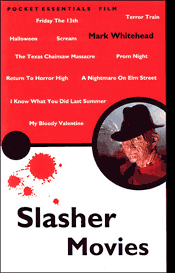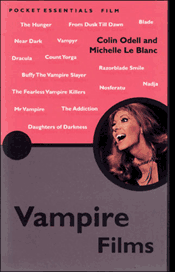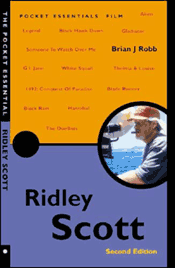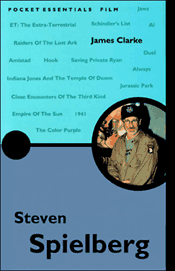Pocket Essentials Offer Pocket Insights
Pocket Essentials, a British publishing venture, offers handy ninety-six-page paperback intros to a large and growing range of topics, from Conspiracy Theories to Sherlock Holmes to Philip K. Dick. They’re particularly strong on film topics. Your faithful correspondent has read four guides of interest to MonsterZine readers.
 I started with Slasher Movies by Mark Whitehead; I needed a reference source on the sub-genre of horror cinema of which I’m least fond, and the Pocket Essentials volume was short and thankfully had no pictures (apart from Freddie Krueger on the cover). Whitehead’s appraisal of slasher movies is admirably balanced. He acknowledges, for instance, that some slasher movies evince hostility to independent women. But in the aggregate these films have a more complicated attitude toward females, as shown through the “final girl,” usually a teenager who keeps her wits as her friends are being slaughtered, and confronts and defeats the maniac. (The primary example is Jamie Lee Curtis’ Laurie Strode in Halloween [1978], Halloween 2 [1981], and Halloween H20 [1998].)
I started with Slasher Movies by Mark Whitehead; I needed a reference source on the sub-genre of horror cinema of which I’m least fond, and the Pocket Essentials volume was short and thankfully had no pictures (apart from Freddie Krueger on the cover). Whitehead’s appraisal of slasher movies is admirably balanced. He acknowledges, for instance, that some slasher movies evince hostility to independent women. But in the aggregate these films have a more complicated attitude toward females, as shown through the “final girl,” usually a teenager who keeps her wits as her friends are being slaughtered, and confronts and defeats the maniac. (The primary example is Jamie Lee Curtis’ Laurie Strode in Halloween [1978], Halloween 2 [1981], and Halloween H20 [1998].)
Whitehead traces the birth of slasher movies from the apprehension of real-life Wisconsin maniac Ed Gein in 1957, through Robert Bloch’s novel Psycho (1959), loosely based on Gein’s career, to Hitchcock’s classic 1960 film adaptation. Also noted is director Michael Powell’s brilliant though commercially unsuccessful Peeping Tom (1960), whose voyeuristic psychopath makes us uncomfortably aware of our own voyeurism in watching him watch his victims. We get a quick glance at Italian giallo films of the ’60s, then on to the breakthrough slasher film, Tobe Hooper’s The Texas Chainsaw Massacre (1974), which “draws the viewer into a nightmare of such visceral impact that it is a genuine relief when it ends,” John Carpenter’s Halloween (1978), a film that even those who hate slasher movies often like, and Friday the Thirteenth (1980), which, despite its faults—”(and there are many), does exactly what it says on the tin. A bog-standard scary movie with slashy effects, cheap shocks and a roller-coaster feel to the proceedings.” In the early ’80s dozens of teens die in the many—and mostly awful—sequels and knock-offs of Chainsaw, Halloween, and Friday. Wes Craven’s A Nightmare on Elm Street (1984) approaches the form with imagination but it too is soon sequelized into tedium.
Return to Horror High (1987) sounds like an amusingly grim pre-Scream parody of the form. Then big-budget Hollywood sneaks the conventions of slasher movies into such mainstream thrillers as Fatal Attraction (1987—Whitehead writes, “The phrase ‘bunny-boiler’ has now entered the vernacular to describe a woman whose social behavior does not conform to the expected ‘norm’.;”), The Silence of the Lambs (1991), Basic Instinct (1992), Se7en (1994), Copycat (1995), and the “demonic slasher” Fallen (1997). Wes Craven’s Scream trilogy (1997–1999) gives at least a temporary infusion of life into a form that had seemed to be dying. Who knows where the future lies?
Whitehead includes “Ten Things to Avoid: A Paranoid Guide to Surviving a Slasher Scenario”— including “4.) Cats. Always in the pay of the murderer, movie cats can lock themselves inside closets in order to leap out at you just when things are at their most tense. They can also calm the most jittery-natured character to a point where they no longer remember that they’ve just received a menacing phone call, been followed by strange figures, have a dark secret in their past, etc. and thus make them easy prey for the bulky figure about to launch themselves from out of the shadows.” Whitehead’s undefensive, unpretentious, and witty narrative melts critical resistance, leading one to acknowledge that perhaps, after all, there’s something to some of these movies.
 I know rather more about vampire films, and spent much of my reading time arguing with Vampire Films by Colin Odell and Michelle Le Blanc. The authors give Tod Browning’s Dracula a rating of “Fang Factor Two” (out of five), writing that the film’s last hour has “only a stalking Renfield to deliver any chills.” What are the two face-offs between Lugosi and Edward Van Sloan—chopped liver? This is akin to doing a book on film noir and giving The Maltese Falcon a rating of “Bang Factor Two.” It calls into question all of the critic’s other judgments.
I know rather more about vampire films, and spent much of my reading time arguing with Vampire Films by Colin Odell and Michelle Le Blanc. The authors give Tod Browning’s Dracula a rating of “Fang Factor Two” (out of five), writing that the film’s last hour has “only a stalking Renfield to deliver any chills.” What are the two face-offs between Lugosi and Edward Van Sloan—chopped liver? This is akin to doing a book on film noir and giving The Maltese Falcon a rating of “Bang Factor Two.” It calls into question all of the critic’s other judgments.
That said, this is a lively and entertaining volume, covering a much wider range of material than the slasher volume. Odell and Le Blanc are eclectic in their tastes, liking Carl Dreyer’s surreal if slow Vampyr (1931; Fang Factor Four), Universal’s evocative Dracula’s Daughter (1936; FF4), Hammer’s masterpiece Horror of Dracula (1958; FF5), the sexy Belgian Daughters of Darkness (1970—“the finest vampire movie ever made”—Fang Factor Six), Guillermo del Toros’ appealingly quirky Cronos (1992), and the mean mysoginistic John Carpenter’s Vampires (1999; FF4). They cast a wide international net, including respective chapters on French director Jean Rollin and Hong Kong vampires, and brief looks at the vampire movies of Japan and Mexico. Agree or disagree with their judgments, you’re likely to come away from this volume motivated to watch and chat about more vampire movies, as is the authors’ cunning plan.
 Film is a collaborative medium, and the French term auteur (author) only properly applies to some directors. In Ridley Scott by Brian J. Robb and Steven Spielberg by James Clarke we get a look at two auter directors, whose diverse films usually reflect their directors’ vision from broad themes to small details. Though Scott and Spielberg are very different, they have in common a mainly visual imagination, which has led critics to disparage their films’ content. (Terry Gilliam and Tim Burton have suffered the same critical myopia.) As Clarke writes, “If it were only dialogue that was important then every film could just as easily exist as a radio play.”
Film is a collaborative medium, and the French term auteur (author) only properly applies to some directors. In Ridley Scott by Brian J. Robb and Steven Spielberg by James Clarke we get a look at two auter directors, whose diverse films usually reflect their directors’ vision from broad themes to small details. Though Scott and Spielberg are very different, they have in common a mainly visual imagination, which has led critics to disparage their films’ content. (Terry Gilliam and Tim Burton have suffered the same critical myopia.) As Clarke writes, “If it were only dialogue that was important then every film could just as easily exist as a radio play.”
Robb details Scott’s (1937–) extensive background in art school, advertising, and as a British television director, all contributing to the maturity and breadth of vision he brought to his first four films: The Duelists (1977), Alien (1979), Blade Runner (1979), and Legend (1985). While Alien was an immediate success, the initial commercial and critical failure of Blade Runner and the studio-imposed butchering of Legend broke Scott’s spirit. Someone to Watch Over Me (1987) was an acceptable if bland police thriller and Black Rain (1989) a better one, but not until the feminist road movie Thelma and Louise (1991) did Scott’s initial boldness return. Since then his films have remained uneven but admirably diverse. 1492: Conquest of Paradise (1992), though a commercial failure, was a serious effort to portray the real life of Christopher Columbus and the complex issues of his career. White Squall (1996) was an attempt to capture the fierce magnitude of a storm at sea, and GI Jane (1997) a return to feminist themes. Robb calls Scott “a consummate creator of unique cinematic worlds,” and sees Gladiator (2000; a film the Academy liked better than I did) as a return to his core skill of world-building. Robb concludes with mention of upcoming projects (including Hannibal and Blackhawk Down, 2001, not yet released at the book’s publication).
Robb quotes one reviewer’s reference to “sporadically great film-maker Ridley Scott,” and that pretty much says it. One comes away from the book with increased respect for Scott’s integrity and good intensions, but continuing to wish that he will again make a film as bold and original as Alien, Blade Runner, or Thelma and Louise.
 Regarding Spielberg, Clarke observes that critics often wrongly separate form and content, and that the form of Spielberg’s films is a large part of their content. Clarke critiques eighteen Spielberg films, from the made-for-TV Duel (1971) through Saving Private Ryan (1998), and gives background on the then-not-yet-released AI (2001). Of particular interest are his critiques of the “monster movies” Duel (whose monster is a truck) and Jaws (1975). Clarke points out the many aspects of Spielberg’s technical virtuosity, while also calling attention to his abiding themes, including loneliness, the search for home and family, and how people grow from facing up to challenges. From this overview one realizes that it’s no fluke that Spielberg is the most popular and influential film-maker alive.
Regarding Spielberg, Clarke observes that critics often wrongly separate form and content, and that the form of Spielberg’s films is a large part of their content. Clarke critiques eighteen Spielberg films, from the made-for-TV Duel (1971) through Saving Private Ryan (1998), and gives background on the then-not-yet-released AI (2001). Of particular interest are his critiques of the “monster movies” Duel (whose monster is a truck) and Jaws (1975). Clarke points out the many aspects of Spielberg’s technical virtuosity, while also calling attention to his abiding themes, including loneliness, the search for home and family, and how people grow from facing up to challenges. From this overview one realizes that it’s no fluke that Spielberg is the most popular and influential film-maker alive.
Each volume includes a list of helpful books and websites. For a complete catalog check out the Pocket Essentials web site. Here’s hoping Pocket Essentials publishes thousands of convenient volumes on every cool subject, becoming our own Encyclopedia Galactica.
